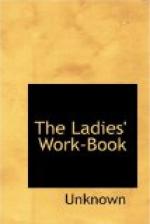To pass from one round to another without breaking the thread.—In working mats and many similar articles this is very desirable. Having finished one round, see whether a s.c., d.c., or t.c. stitch begins the next; for s.c. make one chain, for d.c. three, for t.c. four; slip the needle out, and twist the chain, then continue working. This twisted chain will have all the appearance of a d.c. or t.c. stitch. Should the round not begin exactly in the same place, slip-stitch to the part where it commences, as it will seldom be more than a few stitches in advance.
Square crochet is a term often used, and generally understood, as the engraved patterns are mostly in it. Lest, however, any of our readers should not be familiar with the name, we will explain it. The squares are either open or close. An open square consists of one d.c., two ch.—missing two on the line beneath, before making the next stitch. A close square has three successive d.c. Thus, any given number of close squares, followed by an open, will have so many times three d.c., and one over; and any foundation made for a pattern to be worked in square crochet will have a number of chains divisible by three, leaving one over.
To contract an edge.—In forming leaves and many other things, this is very useful. It can be done in d.c., t.c., or long t.c. Having twisted the thread round the needle as often as the stitch may require, insert it in the work, and half-do a stitch. Instead of completing it, again twist the thread round, until the same number of loops are on, and work a stitch completely. Thus, for two stitches taken in the work, there is only one head. This being successively repeated materially contracts an edge.
To join on A thread.—Avoid joins in open work as much as possible. In close work, whether d.c. or s.c., they will not be perceived. Finish the stitch by drawing the new thread through, allowing a couple of inches for both ends, which you hold in.
To work with several colours.—Hold the threads not in use along the edge of the work, and work them in. When the colour is to be changed, begin the stitch with the old colour, and complete it with the new, which continue to work with, holding the other in. If only one stitch of a colour is to be used, you finish one stitch, and begin the next with it; then change. Colours are seldom intermixed, except in solid work, such as the ends of purses, mats worked over cord, and the like.
To work over cord.—Hold it in the left hand, with the work, and work round it, as you would if it were merely an end of thread. The stitches must, however, be sufficiently close to cover it entirely.
To work with beads.—Beads must be first threaded on the silk, or other material, and then dropped, according to the pattern, on what is usually thought the wrong side of the work. This side presents a more even appearance than the other. It follows that when bead purses are worked from an engraving, they are worked the reverse of the usual way—namely, from right to left.




